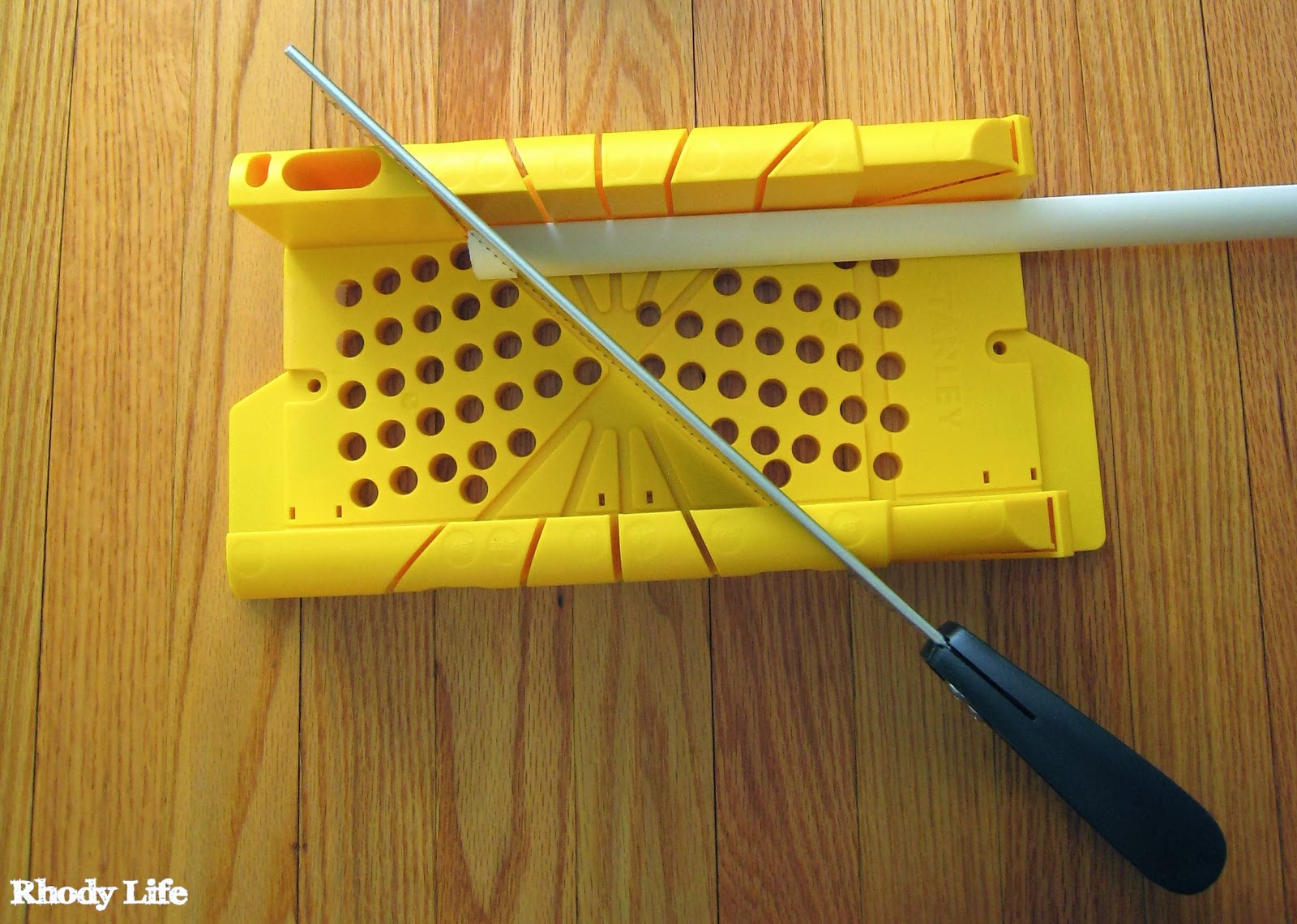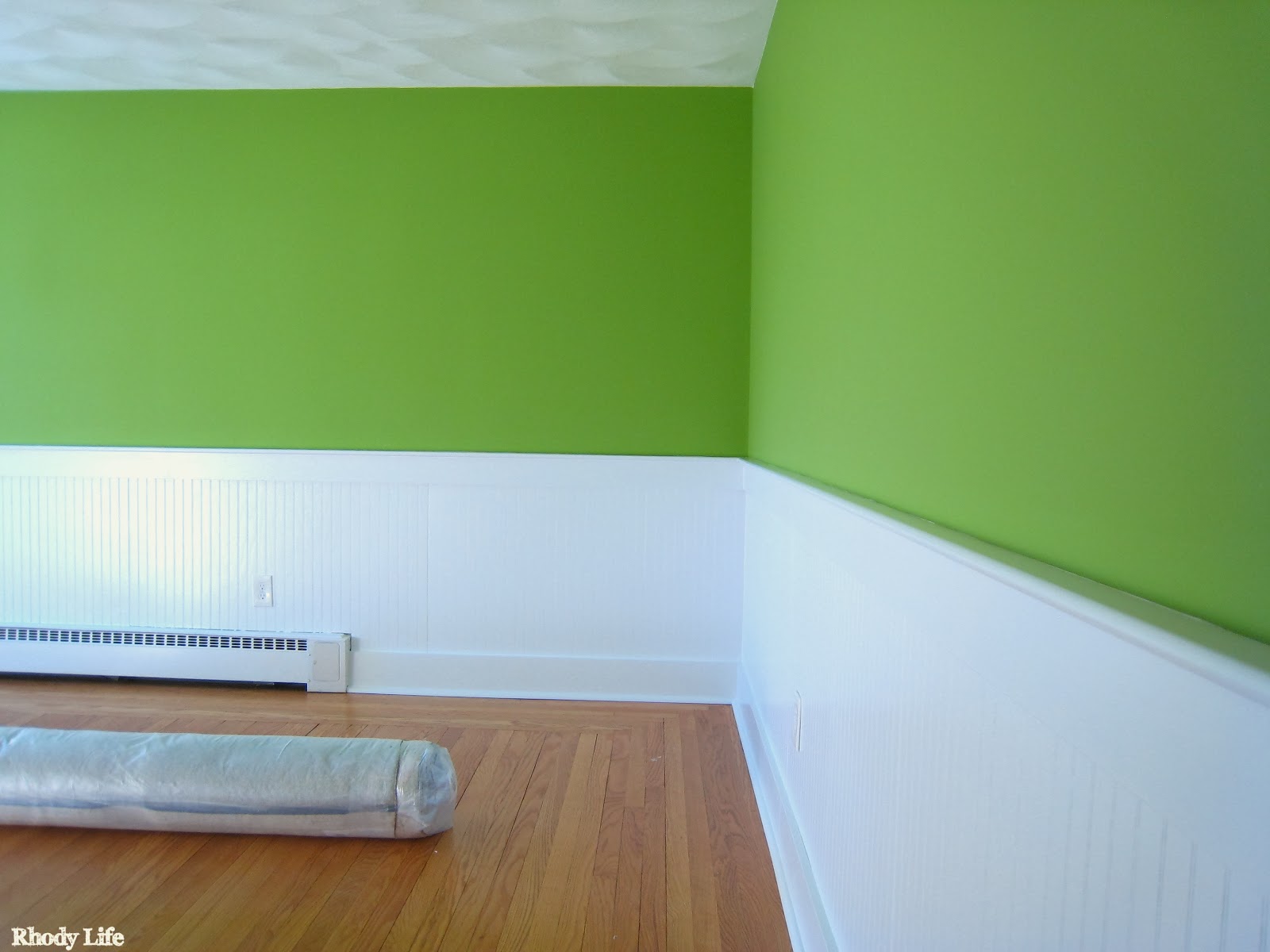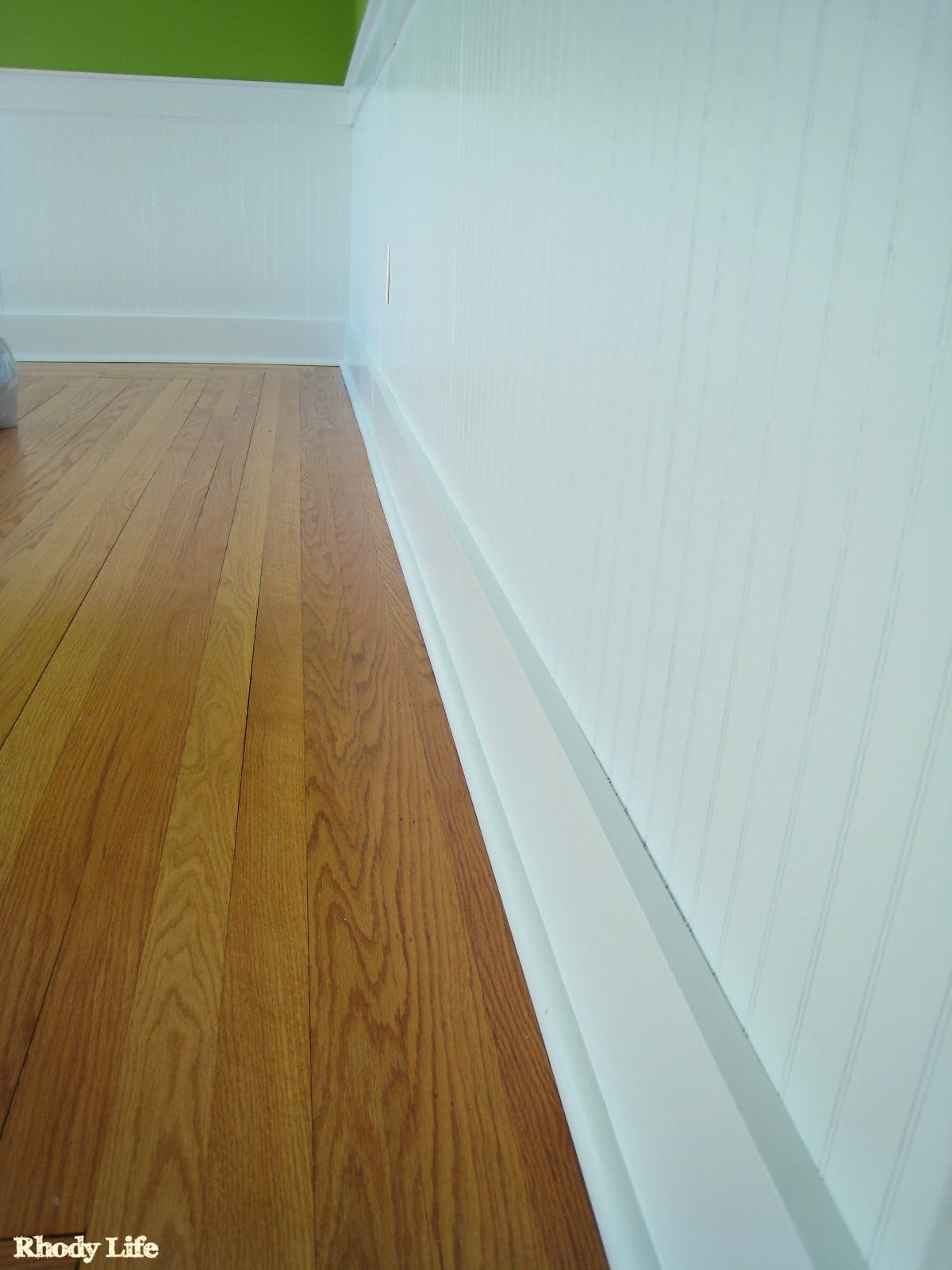This has to be one of the most exciting transformations that I have completed so far using just paint! Are you ready for it? Great, because I can't wait to show you!
Remember the corner bedroom that was the only room in the house that had natural wood-tone trim in it? Well, it's gone! Forever! The same weekend that we painted the small bedroom/craft room, we also tackled this room. With the help of a family friend (Thanks Again!!!) we were able to actually paint two rooms completely, one of which was
the craft room that I already showed you. The other, I haven't yet - I'm not quite finished with some non-paint things, so that's on hold for right now.
But, this room. The transformation is amazing, guys! So let's get to it, right?
Here's the before. Please ignore the large rolled-up rug and the box of crap in the middle of the room. The rug weighs over 100 pounds, and I just didn't feel like moving it.
Boring, right? I mean the wood is nice and all if you like stained wood, even though it's just bead-board, but it wasn't working for me. So, we changed it. And now? I think it looks fabulous!
Huge difference, right? The power of paint, right there folks. I am so in love with it and can't wait to start adding in the furniture I have planned for the space!
Now, while you may think that was just too easy, let me tell you that it wasn't as easy as it looked. It took two coats of green paint, two coats of primer on the wood, and then four coats of white paint in order to get the coverage we needed. And not only that, but I had to do a lot of caulking where the seams on the bead-board were showing and the nail holes were never sealed.
Also, you might not have noticed from the before pictures above, but the quarter round along the base of the moulding wasn't actually quarter round. It was concave, ugly, broken in some spots, and the worst thing I found was that whoever installed the moulding nailed it into the hardwood floors! I couldn't have been more furious when I found that out. But, that explains the giant gaps between the moulding and the bead-board - it wasn't even attached!
Instead of just working with it, however, I decided to replace it. A few 8' sections of quarter round wasn't going to be too much for me to handle, especially when it makes such a big difference in the way the room looks. So, I kept the old molding in place so that I could protect the floors when we were painting, and since the new quarter round I was buying was going to be slightly taller, I didn't have to worry about being neat down there at the bottom.
Once I had three coats of white paint on, I removed the existing foot moulding. And it was so easy. In fact, after I had done one wall, I had to video the removal of the moulding on one of the others, because despite it being nailed into the hardwood floors, it came up like it was just installed with double-sided tape!
Next, I figured out the measurements of the amount of quarter round I needed, and then began cutting, using my miter box. I ended up purchasing PVC quarter round because it was cheaper than wood and was already primed, so it made the project just a little easier for me. Using the existing pieces of moulding as a guide, I was able to figure out the cuts that I would need to join the pieces together. If you are not working with existing quarter round, figuring out the cuts is a lot easier than you would think. For a perfect 90 degree angle, which is what you will typically have in a room, you will need opposite 45 degree cuts on your two intersecting pieces. You want the cuts to be so that the back of the moulding is the longer side, which you can see in the picture below - that is a picture of the right side of a corner piece being cut.

For long walls that you need to add additional straight pieces to, think about the cuts like you accidentally cut a piece into two when you didn't mean to. Those two pieces will go back together perfectly, if you just put them back the same way you cut them. In other words, make sure that the pieces of moulding are facing the direction that you want them to, then do one of the cuts on one of the pieces, and then the same cut on the other. Don't over-think the cuts - they will work out!
Make sure to dry-fit all of your pieces first, that way you can make any changes that you need to with additional cuts or even sanding. You want the pieces to fit tightly, but not too tight, as you don't want them to warp or bend.
After you have your pieces cut perfectly, you are ready for install. I was so excited for this part, because I had just bought myself a pneumatic nail gun! I got it on sale at Sears, and after using some of my points from previous purchases, I only paid $60! Talk about a great deal, right?
I already had my moulding pieces in place from the dry-fit, so I just moved around the room with my nail gun, putting one nail in the center of each piece, and then every 10 or so inches to each side, including one towards the end of each piece. After each piece was in, I tested to make sure that it was attached securely by gently pulling at it and then I added some extra nails when necessary.
Please ignore the gross painting/cleaning/tool-using clothes. I was a stylish DIY'er until I ruined my favorite pair of jeans.
Once all the moulding was installed, I caulked the seam between it and the baseboard, and put a little dab on all of the nail holes, and then put one last coat of paint on everything to blend it all in.
After I was done, I was so proud and amazed at the way the room looked. It's such a dramatic difference in the look, and it is so much brighter with all of the white paint! Now to add some furniture! Woohoo!
Do you have a pneumatic nail gun? Ever installed moulding before? I can't wait to do more!
This has to be one of the most exciting transformations that I have completed so far using just paint! Are you ready for it? Great, because I can't wait to show you!
Remember the corner bedroom that was the only room in the house that had natural wood-tone trim in it? Well, it's gone! Forever! The same weekend that we painted the small bedroom/craft room, we also tackled this room. With the help of a family friend (Thanks Again!!!) we were able to actually paint two rooms completely, one of which was
the craft room that I already showed you. The other, I haven't yet - I'm not quite finished with some non-paint things, so that's on hold for right now.
But, this room. The transformation is amazing, guys! So let's get to it, right?
Here's the before. Please ignore the large rolled-up rug and the box of crap in the middle of the room. The rug weighs over 100 pounds, and I just didn't feel like moving it.
Boring, right? I mean the wood is nice and all if you like stained wood, even though it's just bead-board, but it wasn't working for me. So, we changed it. And now? I think it looks fabulous!
Huge difference, right? The power of paint, right there folks. I am so in love with it and can't wait to start adding in the furniture I have planned for the space!
Now, while you may think that was just too easy, let me tell you that it wasn't as easy as it looked. It took two coats of green paint, two coats of primer on the wood, and then four coats of white paint in order to get the coverage we needed. And not only that, but I had to do a lot of caulking where the seams on the bead-board were showing and the nail holes were never sealed.
Also, you might not have noticed from the before pictures above, but the quarter round along the base of the moulding wasn't actually quarter round. It was concave, ugly, broken in some spots, and the worst thing I found was that whoever installed the moulding nailed it into the hardwood floors! I couldn't have been more furious when I found that out. But, that explains the giant gaps between the moulding and the bead-board - it wasn't even attached!
Instead of just working with it, however, I decided to replace it. A few 8' sections of quarter round wasn't going to be too much for me to handle, especially when it makes such a big difference in the way the room looks. So, I kept the old molding in place so that I could protect the floors when we were painting, and since the new quarter round I was buying was going to be slightly taller, I didn't have to worry about being neat down there at the bottom.
Once I had three coats of white paint on, I removed the existing foot moulding. And it was so easy. In fact, after I had done one wall, I had to video the removal of the moulding on one of the others, because despite it being nailed into the hardwood floors, it came up like it was just installed with double-sided tape!
Next, I figured out the measurements of the amount of quarter round I needed, and then began cutting, using my miter box. I ended up purchasing PVC quarter round because it was cheaper than wood and was already primed, so it made the project just a little easier for me. Using the existing pieces of moulding as a guide, I was able to figure out the cuts that I would need to join the pieces together. If you are not working with existing quarter round, figuring out the cuts is a lot easier than you would think. For a perfect 90 degree angle, which is what you will typically have in a room, you will need opposite 45 degree cuts on your two intersecting pieces. You want the cuts to be so that the back of the moulding is the longer side, which you can see in the picture below - that is a picture of the right side of a corner piece being cut.

For long walls that you need to add additional straight pieces to, think about the cuts like you accidentally cut a piece into two when you didn't mean to. Those two pieces will go back together perfectly, if you just put them back the same way you cut them. In other words, make sure that the pieces of moulding are facing the direction that you want them to, then do one of the cuts on one of the pieces, and then the same cut on the other. Don't over-think the cuts - they will work out!
Make sure to dry-fit all of your pieces first, that way you can make any changes that you need to with additional cuts or even sanding. You want the pieces to fit tightly, but not too tight, as you don't want them to warp or bend.
After you have your pieces cut perfectly, you are ready for install. I was so excited for this part, because I had just bought myself a pneumatic nail gun! I got it on sale at Sears, and after using some of my points from previous purchases, I only paid $60! Talk about a great deal, right?
I already had my moulding pieces in place from the dry-fit, so I just moved around the room with my nail gun, putting one nail in the center of each piece, and then every 10 or so inches to each side, including one towards the end of each piece. After each piece was in, I tested to make sure that it was attached securely by gently pulling at it and then I added some extra nails when necessary.
Please ignore the gross painting/cleaning/tool-using clothes. I was a stylish DIY'er until I ruined my favorite pair of jeans.
Once all the moulding was installed, I caulked the seam between it and the baseboard, and put a little dab on all of the nail holes, and then put one last coat of paint on everything to blend it all in.
After I was done, I was so proud and amazed at the way the room looked. It's such a dramatic difference in the look, and it is so much brighter with all of the white paint! Now to add some furniture! Woohoo!
Do you have a pneumatic nail gun? Ever installed moulding before? I can't wait to do more!











7 comments:
Good to see here you have used an air compressor. Actually a compressor is used in many household chores like painting, DYI, etc. If you searching for the best air compressor you have to review the Best Air Compressor Buyer Guide.
Nice Blog! Well most of your content and image is original and informative. /many thanks for sharing this, cheers. check my blog
Keep sharing about it, these information are really awesome. You can check out best adventure motorcycle helmet
Great article!! I am impressed with this blog work and skill. Thank you so much.
Can’t wait to see your post soon. Good Luck for the upcoming update.
I would like to thank for the efforts you made in writing this Excellent Blog!
Wow, amazing blog format! The total look of your site is wonderful. Thanks
Post a Comment